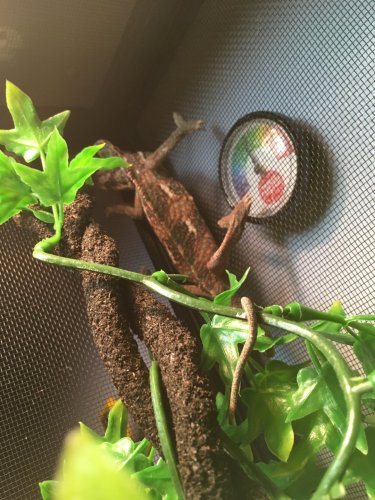Graves923
Chameleon Enthusiast
I feel kinda late to the party on this thread but the photos of the back legs look like theres a slight bow to the bones. Could be a sign of MBD from not using proper supplements.
Glad to see you are adjusting the supplements as suggested.
As for the eyes being closed during the day, this usually mean there is something up with the chameleon or the husbandry. Do you keep any lights on at night? Red light? Purple night light?
Chameleons need almost complete darkness for 10-12 hours to get proper rest and sleep.
Not giving a proper diet of gutloaded feeders could also cause the chameleon to feel weak and close its eyes during the day. I saw you are, as of recently, feeding more crickets which is good. Not sure if anyone went over gutloading already, but make sure to feed your crickets and other feeders leafy greens and vegetables like kale, dandelion greens, escarole, squash. Most commercial gutloads you see in stores suck as the flukers orange cubes are pretty bad.
I would also increase misting times to around 2-3 minutes to make sure the chameleon is stimulated to drink.
And dont take this next part personally about your parents not paying to take a lizard to the vet but this is a topic that irritates me..... As this animals care taker, we are responsible for providing emergency care if it is required. Yes, its just a lizard, but they depend on us for a decent life. If the owner cant or isnt prepared to provide vet care if or when needed, then they shouldnt take the animal in. Its cruel to let any animal suffer in my opinion. Again, i dont mean to come off as rude or anything so I am sorry for the rant.
I am glad to see you are take the advice of the many experienced keeper on these forums.
Glad to see you are adjusting the supplements as suggested.
As for the eyes being closed during the day, this usually mean there is something up with the chameleon or the husbandry. Do you keep any lights on at night? Red light? Purple night light?
Chameleons need almost complete darkness for 10-12 hours to get proper rest and sleep.
Not giving a proper diet of gutloaded feeders could also cause the chameleon to feel weak and close its eyes during the day. I saw you are, as of recently, feeding more crickets which is good. Not sure if anyone went over gutloading already, but make sure to feed your crickets and other feeders leafy greens and vegetables like kale, dandelion greens, escarole, squash. Most commercial gutloads you see in stores suck as the flukers orange cubes are pretty bad.
I would also increase misting times to around 2-3 minutes to make sure the chameleon is stimulated to drink.
And dont take this next part personally about your parents not paying to take a lizard to the vet but this is a topic that irritates me..... As this animals care taker, we are responsible for providing emergency care if it is required. Yes, its just a lizard, but they depend on us for a decent life. If the owner cant or isnt prepared to provide vet care if or when needed, then they shouldnt take the animal in. Its cruel to let any animal suffer in my opinion. Again, i dont mean to come off as rude or anything so I am sorry for the rant.
I am glad to see you are take the advice of the many experienced keeper on these forums.




